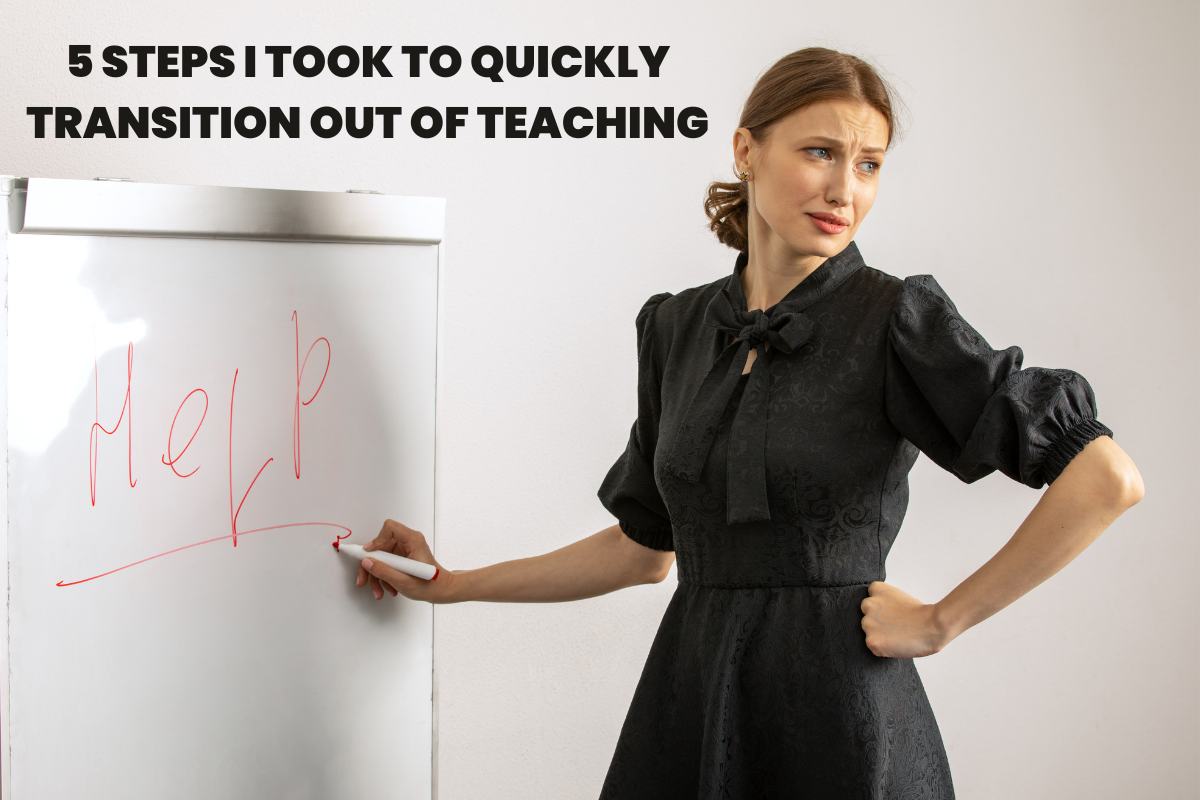I successfully transitioned out of teaching and resigned over Christmas break. When I returned to finish out my contract in January, there were, of course, several co-workers who wished me well or told me they would miss me. But, what surprised me was the number of fellow teachers who asked “How’d you do it?” Although my transition out of the classroom happened much quicker than it does for most, it certainly did not happen overnight. There was a lot of thoughtful work that went into it.
Here are the top 5 things I did in the months leading up to my resignation:
1: Mindset Shift
First and foremost, I made the decision that I was done. Not just “I’m getting tired of this and I think I want out” but actually making the mindset shift that I was through. This helped me start to feel less emotionally connected to my work and honestly led to a little bit of “quiet quitting”. Once I decided that I was definitely going to transition out of teaching, I felt less connected to my work and found it easier to say no or leave at the end of the school day.
2: Goal Setting
I set a goal of quitting by the summer and made the conscious decision that I would do whatever it took to make that happen. Transitioning out of the classroom can take several months of work. If you want to leave before next school year, don’t wait until June to start working on that goal. Start now.
3: Choose a Target Role
At first, I had no idea what I would do other than teach. After all, I had planned and practiced for being a teacher since I was a kid. It’s all I ever dreamed of doing. But I knew I wanted to transition out of teaching soon so I researched other viable careers. I literally started by googling “good jobs for teachers who are leaving the profession”. I found lists and looked into things that interested me. For me, it was instructional design. For you, maybe it would be copywriting, project management, customer success, or something else.
Tip: The Teacher Career Coach is a great place to start. She has a great list of careers and even has a quick quiz you can take to see what career outside of the classroom might be best for you.
4: Upskill and Create a Portfolio
Once I had chosen a target career, I spent every extra minute learning about how to transition to that field. I listened to podcasts, watched YouTube, and read articles. I spent my lunch breaks reading, listened to content on my commutes, watched videos while I cooked dinner, and spent any other spare moment learning about instructional design. After I put the kids to bed, I was “upskilling” in specific skills and software and creating products I could put on a portfolio site.
Tip: Earbuds are your friend. I even listened to videos and podcasts while I was doing hall duty!
5: LinkedIn
LinkedIn is HUGE in most industries outside of education. If you aren’t on LinkedIn, it will be really difficult to look legit in a lot of the fields that teachers typically transition into. My approach to LinkedIn was multifaceted:
- I started by optimizing my profile for the industry I was looking to get into. I added my experience but reframed it in terms that hiring managers would be looking for. I added a nice photo and intro video. I designed a banner image. I composed a good tagline to show under my name. I asked former administrators and colleagues to leave me recommendations. I added a link to my portfolio. There was a lot of work that went into this step.
- Then, I started connecting with people in the industry I was hoping to join. I started with the content creators I had been watching on YouTube. Then, I searched “Instructional Designer” and added anyone who came up in my suggestions. (LinkedIn is not like Facebook where you really just want people you already know. It’s all about making NEW professional connections.)
- I purposefully engaged in conversations about Learning and Development, Transitioning Teachers, and just education in general. I found at least one or two posts from my feed every day to comment on. My goal was to engage in conversations in order to make new and more meaningful connections. I also joined a group specifically for people looking to transition out of teaching into Learning and Development and engaged in conversations there. All this engagement helped more relevant people come up in my recommended connections and was ultimately how I saw the post that advertised the job that allowed me to leave teaching.
- I searched the LinkedIn Job board daily. Even though I wasn’t ready to apply to most jobs yet, reading the job descriptions gave me a better understanding of what I needed to be working on. Ultimately, I ended up finding a job through a post that was shared by a connection, not the job board. So, making those connections is important and can really pay off!
If you are also trying to transition out of teaching, I hope this list helps give you guidance. If you are really serious about leaving, you need to make purposeful, calculated actions to make your transition dream a reality. You’ve got this!
Want someone to talk it out with? Find me on LinkedIn. I’m always happy to connect!








